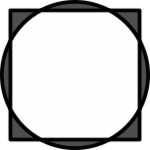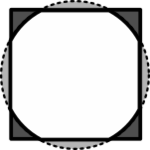Malakhov P. - Squaring the Circle: Difference between revisions
(Created page with "{{MTT publication | author = Pavel Malakhov | title = Squaring the Circle | subtitle = | issue = 2019-2 | number = 8 | publications = The Theosophist. Vol. 144.10, Ju...") |
(No difference)
|
Revision as of 10:00, 20 October 2023
Squaring the Circle
Squaring, in fact, means calculating the area of a figure or surface. By the latter, old Greek mathematicians meant building a square equal to the given figure, hence the term. Modern mathematics employs a more common term, integration, while continuing to use the old term for purposes of classical problems. Thus, the problem of squaring the circle is one pertaining to finding its area, which can be done by various methods. Yet, the term squaring the circle has a well-established and definite meaning which has its origin in the Pythagorean School, i.e., building a square proper whose area is exactly equal to one of a circle rather than just calculating its area. As mathematics in general, and geometry in particular, were perceived by Pythagoras and his disciples philosophically or as tools designed for learning universal laws by means of the law of analogy, let us try to treat the problem set philosophically and look at it from various angles.
An understanding of the components and key parameters that describe a circle and a square will help us better conceive the meaning of squaring the circle. Reflection on each of them on the one hand, and comparison with the analogue in the second figure on the other, can reveal many secrets.
Geometrical Aspect

Building a square equal in area to a circle is not an easy thing to do, since the features of these geometric figures require different tools to build.
The circle is defined by three parameters: the center point, the set of points equidistant from the center, and the distance from these points to the center. For this, geometry has corresponding concepts, such as center, circle and radius.
A square is defined by the length of a side and the right angle formed by joining each pair of adjacent sides.
The area of a circle is found by the formula: S = πR2, while the area of a square: S = a2.
Now, what must be the side of the square so that its area is equal to the area of the circle? Simple mathematical operations give the answer: a = R√π, i.e., the length of the side depends on π (pi), an irrational and transcendental number, one that does not have a complete expression in the form of a decimal fraction. In practice, this means that such a square cannot be constructed using a ruler and a pair of compasses. There is a purely theoretical solution employing a special curve called quadratrix, which however being also of a transcendental nature,[1] thus means that it cannot be accurately constructed using physical tools.

Some mathematicians closed the question at this stage, concluding that the problem of squaring the circle is unsolvable. If we proceed from the narrow task of graphically constructing a square equal in size to a circle using a compass and a ruler, then yes, the task is impossible, but geometers were engaged in calculations not only for practical construction and engineering purposes. As philosophers they sought to study the very properties of figures and ways to measure them, and, based on these illustrative examples, tried to delve into invisible relationships and laws, believing those had similar properties.
The language of mathematics is a language of symbols, well suited for formalization (i.e., a specific description) of various areas of knowledge. Some areas of knowledge are difficult to understand when described in their own terms. A descriptive way of expressing a thought can prove very lengthy and confusing, while mathematical symbols and operations enable one to reduce a thought to a concise form — a formula.
Let us try to consider the squaring of the circle as one of these formulas, which clearly illustrate rather intricate concepts offered by various branches of knowledge.
Cosmogonic Aspect
To describe the evolution of the world (cosmogony) as a process, one can use a number of simple symbols (as is done, for example, in the Book of Dzyan), whose meanings can be instrumental in developing a more detailed understanding of a rather abstract process.[2]. Three symbols — a circle, a circle with a diameter, and a square — would be sufficient for our task.
The circle represents the oneness of the future world, the fullness of information about it covering all its laws, objects, and processes. It stands both for the Universe remaining in its pregenetic state and for its potential, or Ideal, during its manifestation.
The diameter is just two radii pointing in exactly opposite directions. Therefore, it is well suited as a symbol of duality, polarity, and the idea of opposites. Any two radii divide the area of the circle into two parts, but it is only the diameter that makes these parts equal, which is also a good illustration of duality — that duality which is equal in size. The number of diameters in a circle is infinite, while all the diameters are limited by the same circle common to all. This property of limited infinity is well suited to illustrate the law of duality, which manifests itself in all the processes current in the One Universe: in the spiral movements of cosmic bodies (attraction-repulsion), in the material- spiritual (or energy) structure of all objects, in the daily moral opposition of good and evil, and in all other cases, where we can find an opposite for each phenomenon. Opposites generating movement (or transformation) from one extreme state to another, the diameter therefore is well suited as a symbol for any creative power.
A circle with a diameter represents the beginning of the world manifestation. This is the stage where conditions and rules are defined according to which the world will manifest itself, the differentiation begins covering all pairs of opposites that come from the one essence, the transition takes place from “was not” to “became”, from rest to movement, from homogeneity to diversity, from nonnumber to numbers, enumerations, etc. The determination of laws prior to the appearance of objects is the so-called “primary creation”. This symbol links the idea (circle) and its manifestation (square). It symbolizes the transitional or preparatory processes, or rather, it symbolizes the end of the world’s preparation for manifestation, while the beginning of that preparation is symbolized by the central point in the circle. With the diameter appearing in the circle, manifestation begins.
The square represents the world itself, as we perceive it. On the one hand, it stands for the totality of objects and phenomena, while, on the other, the totality of all subjective ideas about these objects and phenomena. In other words, it includes everything that can be observed or perceived, as well as all the observers themselves with their own opinions and ideas about what they have seen or perceived. This is the “secondary creation” or the manifestation of ideas in certain forms.
The cosmogonic solution for squaring the circle, therefore, lies in the building of a visible[3] world. This process may be summarized into four aspects (this being among the reasons why it is symbolized by a square):
- the emergence of a prototype (or idea) of the world, which includes all the laws according to which the world will be built;
- the emergence of an image (or a thought-image) that determines the plan and details of the manifestation;
- the emergence of substance and elements — a medium for manifestation;
- the appearance of physical objects — the final clothing in forms.

The above order is rather arbitrary, since it is difficult for us to imagine any of the aspects in isolation from the rest. Usually, they are presented in the given sequence in order, among other things, to highlight a decrease in the world’s energy component at the expense of the growing predominance of the material component — in other words, the transition of energy into matter, of movements into objects, of force into form, etc. These stages (when thus seen) do not end when the next one appears, but serve as a constant source and filling for each other. As they complement or reveal each other’s features, they can be best illustrated graphically with a square having two crossing diagonals.
Philosophical Aspect
The form (or shape) of any figure is an external constraint that determines its properties. The area of a figure is its inner content, meaning, and substance. It is the form that determines the manner in which the meaning will be expressed. The invariability of the area in different forms suggests the invariance of the meaning in its different expressions. This idea, clearly expressed in geometric terms, corresponds to one of the main tenets of Theosophy: all world religions and philosophies have one source and express the same moral and cosmic laws, only rendered in different words. The squaring of the circle helps us understand more deeply the idea of the One Life manifesting itself in different forms. To build a square equal to a circle in area means to express in it the essence and meaning of the circle, i.e., to transfer everything that was contained in the circle to a different form, using appropriate analogies and rendering adequately each feature of the circle to a square.

The graphic representation of these figures having the same area, when superimposed on each other, emphasizes one important feature: their shapes go beyond each other’s limits. This means that each of the forms has points that do not belong to the other and thus make this form unique. And yet, the uniqueness of the forms notwithstanding, the content of both figures is the same, their areas (that is, the totality of all points) being equal. This graphic representation leads to the following two interesting conclusions:
1) This is a good illustration ofUnity in diversity. This simple example shows how the One Life can manifest itself in all the variety of its forms without changing its essence.
2) The same illustration can help us approach an understanding of Universal Brotherhood which includes not only humans, but all kinds of beings. We are all different. Our forms — physical, sensual, and mental — are all unique and individual, but, in fact, they are merely reflections of the One Life. We find it easier to understand those people whose interests and world views coincide with our own, i.e., where the areas of our figures intersect. However, where the form of another person goes beyond our own limits, misunderstanding appears. Yet, it is precisely where the expansion of our own consciousness or our own development begins.
Squaring the circle, when understood philosophically, provides the key to understanding universal symbols as it enables one to look beyond the symbols’ outer shape and see their essence (area). Taking plane geometric figures as an example, the lover of Wisdom can ponder on what precisely makes them essentially the same, whatever their apparent difference in form, and then he will find it easier to see the identity of more complex symbols.
Theological Aspect

Let us look again — but from a slightly different angle this time — at those parts of the two figures that go beyond each other’s boundaries. We see four truncated parts, called segments in geometry, that remains from the circle. What remains from the square is four triangles, one side of each of which is an arc. The radius of curvature of this arc, being a continuation of the same circle, is equal to the radius of curvature of the segment. Thus, what is external for one figure is internal for the other. Theologically, this can be interpreted as God (the circle) manifesting himself (the circumference) in every being (the square or any other figure) as that being’s inner nature. Also, this means that God, his power transcending our comprehension (the outer segments of the circle), can at the same time be found within our own nature (the arc of the triangle) as well.
Of particular interest are the parts of the square that extend beyond the circle. If the circle is said to be a symbol of the all- encompassing and allinclusive God, possessing the totality of Knowledge and boundless Power, then what can there be outside of him? A similar question can be added to this one: “Why should the all-encompassing Absolute (which contains everything that was and everything that will be) manifest at all? What is the purpose and meaning of everything that happens, once the final result is already known?”
One possible answer to these questions, transcendent for a human being, can be experience. Experience is proven knowledge, something an individual has lived through and felt. You can describe in detail a path climbing to the top of a hill. You may know perfectly well the peculiarities of the hill, its flora and fauna, minerals, air composition, and climatic characteristics. You may imagine clearly all the physiological features of a person performing a hard ascent uphill: muscle tension, sweating, rapid heartbeat, etc. You may have a complete idea of all the difficulties and dangers. You may, finally, understand the delight that a traveler feels when he rises to the top and contemplates the vast expanses below. Every detail of this path may be known and explained beforehand, but still this knowledge will not be complete unless experienced individually. It is experience alone that shows the difference between theory and practice, the ideal and life, dreams and action.
If we are to see any sense in the affairs of God, experience may provide the appropriate explanation to what is meant by squaring the Divine Circle. Let us consider in more detail the meanings that can be attached to symbols in order to represent this complex metaphysical process more accurately and fully, and, thus, make it more obvious and clearer to us.
The circle is a symbol of the Divine World or, collectively, of God. The square, in turn, is a symbol of the manifested world, the world of forms.
The area of the circle is the totality of all laws, while the area of the square is the manifestation of these laws. The former contains the prototypes of all things and the variety of their possible modifications while the latter is what reveals and transforms these prototypes into objects (things, beings, etc.) and makes these transformations possible. The area of the circle may be called the fate of the world (its karma, potential), while the area of the square is life, which brings this fate into manifestation by making it objective or a fait accompli. Thus, squaring the circle proves to be nothing but evolution, the progress of the manifested world, revelation of the Divine Plan in its entirety.
An interesting geometric definition of God, known to us through Blaise Pascal, enables us to delve deeper into the essence of the divine nature. He said, “God is a circle whose center is everywhere and circumference nowhere.”

The centre of the circle is the point of balance, rest or potentiality of everything. It is the source ofall would-be manifestations. This is a laya-centre, a state of non-manifestation, homogeneity (non-differentiation). As any point in space contains the possibility of manifestation, the centre of the circle is everywhere.
The radius is the power of the Divine force, the manifestation ofpotentiality, movement, and activity per se. The radius indicates how far manifestation has distanced itself from the source. This activity spreading with equal force in every direction of space, we can speak of countless radii forming a circle, and countless concentric circles, if we take into account the movement. Remarkably, one of the meanings of the word radius is “ray”, i.e., a directed movement that has a source and does not have an end, rather than just a limited segment connecting two points.
A circumference is defined as a set of points equidistant from the centre. Likewise, the Divine Thought (or Power) spreads equally in all directions. The circumference, seen as the boundary of the circle or as its maximum power, is represented by the highest hierarchies of Divine Powers, the highest representatives of God, the expression of His might. In fact, what we mean when talking of God or trying to imagine Him is His manifestation, i.e., the results of certain activity, and since the latter is present at every point in space, the circumference (the line beyond which there is no longer a circle whatever) defies definition. In other words, it is nowhere.
The two-fold diameter (two radii pointing in opposite directions) represents the Creative Powers that bring forth the Divine Thought into the manifested Universe. The geometric key of the diameter gives an idea of the non-contradictory nature of the apparent duality of the world, on the one hand, and the existence of the One Life, on the other. Diameter is a secondary concept arising from the concept of radius and also formed from the concept of chord. A chord is the distance between two points on a circumference, or the relationship between all possible extreme (or expressed to the utmost degree)[4] manifestations, and when it comes to express the relationship of opposites, this special relationship is endowed with its own distinctive name, diameter.[5]
Together, all these concepts (characteristics of the circle) represent the Divine World, collectively called God. With God beginning to act, a source of energy appears in space, known also as the source of a space curvature or the source of radiation of material particles. In other words, the center of a circle appears, a circle accompanied by a circumference. What makes the circle so good as a symbol is its clearly showing that the power of the Divine Nature can be manifested at every point in space and the degree of that manifestation is determined by an infinite radius — a ray. Any light source that emits its rays in all directions can be taken as an additional illustration of this idea.

Now, having described the meaning of the symbols of the circle, if we want to express the idea of the incarnation of the Divine Thought in the manifested world, we have to resort to the radius and, using this value, build a square by finding a suitable analogy. Thus, the power of the circle will be determined by its radius as much as the power of the square will be determined by the length of its side. By constructing a square with a side equal to the radius, we get a symbol of the realization of the Divine Thought in the world of forms. As becomes obvious from this construction, the Divine Thought cannot be realized in full
(since the areas occupied by the figures are different), some meanings (ideas) remaining outside the manifestation. In order to comprehend them, one has to go beyond the limits of the manifested world, which is possible only by the instrumentality of metaphysical thinking.
In the manifested world, the Divine Idea can take the shape of a square, whose side is equal to the radius, but to adjust this form of the manifested world, in content (area), to the Divine Form, we must use a certain mathematical coefficient that will bring the manifested idea in line with the unmanifested idea. In order to bring one in conformity with the other, one has to solve the problem of squaring the circle, or compare the Divine Thought with itself as manifested in our world. The nonconformity is striking the eye, for our world is imperfect and subject to a constant distortion of Divine Laws. To make it perfect, we must transcend the circumstances that surround us daily, since these daily occurrences are all but attempts to manifest the perfect world. To soar to the heights of the perfect Divine World, we, actually, have to go beyond the appearances in our perception of events. Only then can we comprehend the Divine Thought and try to translate it into life. Graphically, this is well represented by the circle going beyond the square and the square going beyond the circle.
The undoubted advantage and benefit of geometry lie in its ability to represent sophisticated ideas visually. A simple image of the squaring of the circle can give us an illustration of the process of cognition or improvement, enabling us to transcend the limits of any figure. Mathematical formulas help us see that there exists a specific expression for the efforts we must undertake in order to transcend the forms that limit us. Just as there is a certain speed (a numerical characteristic of movement) required to overcome the attraction of the Earth and the solar system (the first and second cosmic speeds) — a certain objective characteristic of our efforts — so there is a certain characteristic of internal forces that enables us to transcend the world of forms and enter into the Divine World. This characteristic is expressed by pi.
Formulas for calculating the areas of a circle and a square provide much food for thought also regarding the metaphysical meaning of squaring the circle. The area of a circle is equal to pi multiplied twice by the radius, that is, by the radius squared: S = πΕ2. In other words, if we take a square with a side equal to the radius and increase its area by pi times, then we get the area of a circle. That is, the realized or manifested universe is less than the one contained in the Divine Plan. It does not reflect it fully. This means that, even possessing the total knowledge about the manifested world, we must expand it more than three times in order to get closer to the knowledge of the Divine World. Isn’t it the geometric key to the Trinity as a triune Deity? The fact that the ratio of the two worlds cannot be expressed by an integer is also very symbolic. What the Trinity brings to fruition is our whole world, but our world is just one of the stages, one coil in an endless spiral of perpetual motion. There is always room for progress and for the next cycle of development. Numbers like pi are called transcendental, they are borderlines transferring one state into another, or one world into another, or one cycle into another.
Thus, squaring the circle theologically means to reflect and see in the daily phenomena of life, in our daily experience, the fullness and integrity of the Divine Plan, that is, put each phenomenon in its proper place and give its proper meaning in the overall system. In other words, to know the One Life. Or, rather, not to know, but to remain a knower ever filling up the gaps, since the value of the number pi can be specified endlessly, as well as our understanding of life.
In conclusion, we can briefly give a few more solutions to the squaring of the circle in other fields:
- Linguistic (philological) solution: convey the full meaning of a thought by expressing it in various words and in various languages.
- In designing, programming, etc.: find a solution that meets perfectly the terms of reference.
- From a moral point of view, this can mean such behavior of a person that is fully consistent with his higher nature.
Thus, using the law of analogy, one can likewise square the circle in various areas of human activity. When we understand that everything in the world is interdependent, it will become easier for us to understand how this world works. It is precisely the domain of Theosophy to show convincingly that there is only One Life in the world, and everything we can see around ourselves is just its manifestations. These phenomena are diverse and incompatible at first glance like a square and a circle, and yet, they are only a manifestation of the One Life, the one area in the diversity of forms.
Footnotes
- ↑ The quadratrix is described (or defined) analytically and dynamically, rather than using an algebraic formula. See Wikipedia.
- ↑ This is described in detail in the Proem of H. P. Blavatsky's The Secret Doctrine.
- ↑ Visible in a broad sense, as the ability to be perceived by anybody at all. This includes not only physical senses, but also all sensations, mental images, and intuitive perception.
- ↑ Extreme, since we deal with points on the circumference rather than points on a circle. The points inside the circle express a variety of possible degrees and variants.
- ↑ The word diameter (Greek διάμετρος) comes from διά “through; separately” and μετρέω “I measure” or μέτρον “measure”, which adds another meaning to this concept: comprehension of a circle through measurement or comparison of opposites in it.
